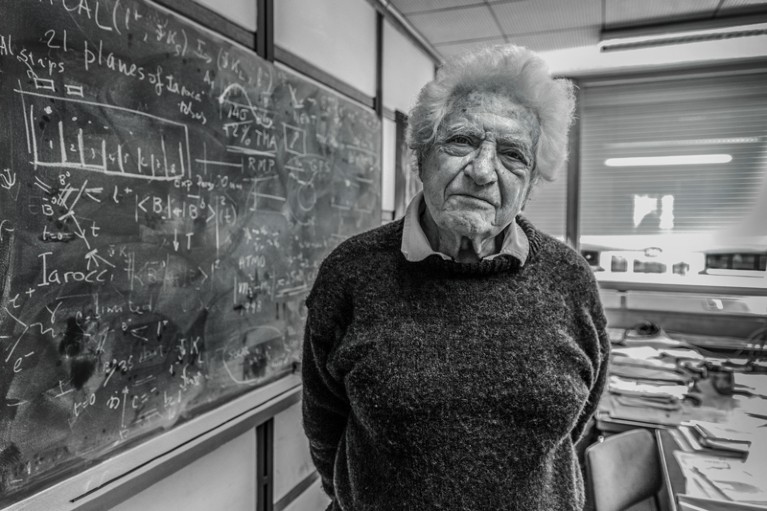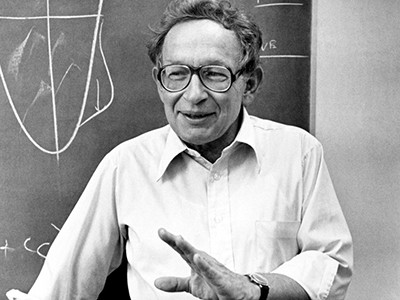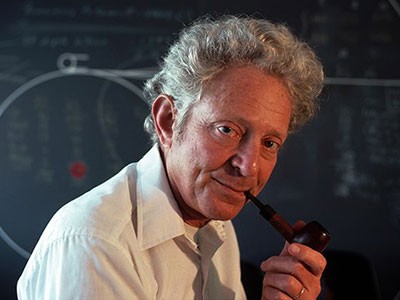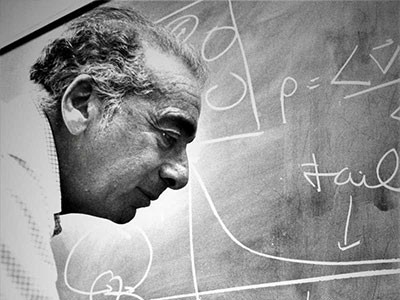
Credit: Sophia Elizabeth Bennett/CERN
When particle physicist Jack Steinberger began his career in 1945, scientists knew about only a handful of subatomic particles. Today, dozens are evident, and their basic building blocks are codified in the standard model of particle physics. Steinberger, who has died aged 99, contributed throughout — from discovering particles to grouping them. He shared the Nobel Prize in Physics in 1988 (with Melvin Schwartz and Leon Lederman) for a 1962 experiment that revealed the existence of two distinct types of an enigmatic particle: the neutrino.
Neutrinos barely interact — they can pass right through Earth. They have no electric charge and respond to the ‘weak’ nuclear force, which acts within atomic nuclei and governs radioactivity. They were predicted in the 1930s, to account for the unexplained energy released alongside electrons in radioactive decay. Steinberger and his colleagues showed that there was more than one type of neutrino. They found a second, associated with the muon — a particle similar to the stable electron but 200 times heavier and with a shorter lifetime. Steinberger also helped to pin down the properties of quarks, the ultimate constituents of protons and neutrons.
Born into a Jewish family in Germany, Steinberger was evacuated soon after the Nazis came to power, arriving in the United States in 1934. His foster parents in Chicago, Illinois, ensured that he received a high-school education and reunited his family there in 1938. Steinberger first studied chemistry at the University of Chicago. He joined the US Army on his graduation in 1942, less than a year after the United States entered the Second World War. He worked with physicists at the Massachusetts Institute of Technology in Cambridge on the use of radar to improve the accuracy of aircraft bombing.
After the war, Steinberger returned to the University of Chicago to pursue physics research. He was supervised by Nobel laureate Enrico Fermi, who had demonstrated the first nuclear chain reaction. Fermi, who had also worked on the theory of the neutrino and coined its name, pointed him to a puzzle concerning the decay of the muon, which had been found in cosmic rays in 1936. The particle broke down into an electron and missing energy. Steinberger attributed the energy to not one but two neutrinos, a hypothesis he confirmed experimentally in 1948.
The desire to exploit new facilities and techniques was a hallmark of Steinberger’s research. In 1949, he joined the Radiation Laboratory at the University of California, Berkeley, where he used an innovative accelerator to study another cosmic-ray particle, the pion. He showed the existence of the short-lived electrically neutral pion, the lifetime of which he had earlier calculated theoretically. But he left for Columbia University in New York City in 1950, owing in part to his refusal to sign an anti-communist oath. There, he exploited the newly invented bubble chamber — which reveals trails of fast-moving particles in liquid propane or hydrogen — to make discoveries about the plethora of new particles that were being unearthed. These included ‘strange’ particles, so called because they decay more slowly than expected.
It was at Columbia that Steinberger and his colleagues conducted their Nobel-prize-winning experiment. Steinberger’s former student Schwartz worked out how to make a beam of high-energy neutrinos. The team harnessed a new accelerator at the Brookhaven National Laboratory, New York, and built a fast-acting detector that made particle tracks visible as trails of sparks. It was on a massive scale. A 13.5-metre-thick steel shield, made from armour plates from scrapped warships, was used to block all particles except neutrinos, and a 10-tonne spark chamber was constructed to spot the ones produced.
Steinberger moved to Europe in 1968 to CERN, the particle-physics laboratory near Geneva, Switzerland. The multiwire chamber, which had just been invented there, was able to collect data thousands of times faster than a bubble chamber could. Steinberger used it to extend his studies of strange particles. In 1983, he led the design and construction of a large experiment called ALEPH to exploit CERN’s Large Electron–Positron collider. In 1989, ALEPH helped to demonstrate that there can be no more than three types of neutrino — the electron and the muon neutrinos, and a third associated with the tau particle, another ‘heavy electron’ discovered in 1975. This neatly completed the story that Steinberger had begun with his PhD thesis.
Philip W. Anderson (1923–2020)
Steinberger retired from CERN in 1986, but continued to work with ALEPH researchers until the mid-1990s. He extended his interests to astrophysics and climate change, and in 2015 joined other Nobel prizewinners in signing the Mainau Declaration, urging governments to limit greenhouse-gas emissions.
Jack Steinberger was admired for his instinct and prowess as an experimental physicist, his intellect as a teacher and supervisor, and for being a great friend. He was not always right — after losing one bet with theorist friends about an aspect of physics, he paid up with good wine. He had a deep interest in how nature works, and enjoyed mountaineering and sailing.
Uninterested in prizes, he often reiterated his belief that “the pretension that some of us are better than others [is not] a good thing”. He felt he been dealt lucky cards in his life, and expressed his deep gratitude to the Chicago family who gave him opportunities as a child. In his words: “You have only one life: whatever crops up, crops up.”



 Berni Alder (1925–2020)
Berni Alder (1925–2020)
 Philip W. Anderson (1923–2020)
Philip W. Anderson (1923–2020)
 Freeman Dyson (1923–2020)
Freeman Dyson (1923–2020)
 Murray Gell-Mann (1929–2019)
Murray Gell-Mann (1929–2019)
 Leon Lederman (1922-2018)
Leon Lederman (1922-2018)








